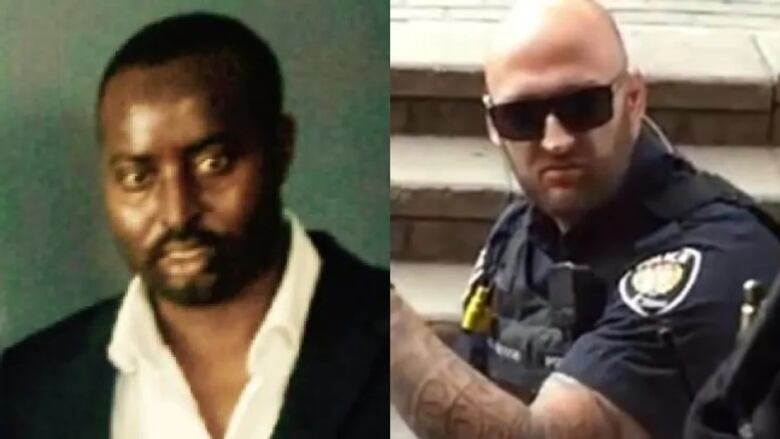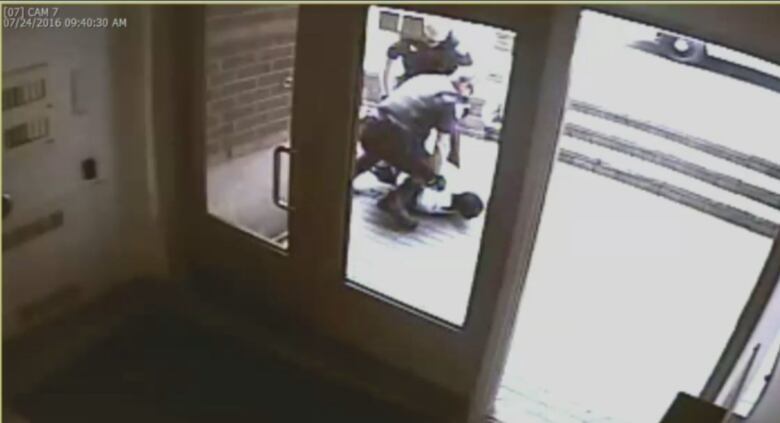Difficult to prove punches killed Abdirahman Abdi, pathologist testifies
Dr. Christopher Milroy says damage from gloved punches not only possible cause

The pathologist who examined Abdirahman Abdi's body saidhetold lawyers for both the Crown and the Special Investigations Unitthey'd have difficulty proving blows from a police officer's gloved fist killed the Ottawa man.
Dr. Christopher Milroy, Ottawa's chief pathologist, acknowledged on Thursday under cross-examination by lawyers for Const. Daniel Montsionthat he brought up causation issues in determining Abdi's death.
Montsion has pleaded not guilty to charges of manslaughter, aggravated assault and assault with a weapon in Abdi'sJuly 2016 death.
The court has already heard that Montsion punched Abdi twice in the head when he first arrived at55 Hilda St.on July 24, 2016, to arrest him.
After Const. Dave Weir pushed Abdi to the ground, Montsionpunched him in the head two more times as they tried to get him into handcuffs.
Paramedics discovered that Abdi hadno vital signs when they arrived on scene roughly seven minutes later. Montsion was wearing Oakley assault gloves with reinforced knuckles during the arrest.
-
Deadly weapon? Ottawa police assault gloves scrutinized after officer charged in death
-
Assault gloves aren't approved police weapons, Montsion trial told
Milroy told court he spoke to lawyerswith the province's Special Investigations Unit (SIU) and the Crownduring a meeting in November 2016, four months before Montsion was charged.
Milroy concluded that Abdi died of homicide by heart attack, and that the gloves did extensive damage to his face.
But over threedays of testimony in court, he explained that's not the only possible explanation for Abdi's injuries or death.
Casting doubt
Milroyexplained that Abdi had an underlying heart condition and that two of the main arteries in his heart were 80 per cent blocked.
A number of factors could have contributed to Abdi's death, he said, including the physical exertion from the chase, struggle and his facial injuries.
"He could have dropped dead at any time," Milroy told court.
Montsion's defence team entered into evidence arecording of a telephone interview Milroy had with the SIU's lawyers in January 2017.
In the audio played for the court, Milroy said he couldn't determine exactly when Abdi's cardiac arrest "was going to become inevitable."
He saidthat if Abdi had reached a point where he was certainlygoing to have a cardiac arrest, additional blows wouldn't make a difference.
"Is it possible that you haven't quite reached [that point] and the blows just add a bit more? Yes it is. That's why I've put them in the cause of death," Milroy told the SIU's counsel in the recording.
"But equally, I recognize that there is a causation issue in the sense of what parts of those were necessary [to Abdi's death] as opposed to were just potential contributors."

Off hismedications
Milroy also described to the court the various anti-psychotic drugs Abdi had been prescribed. He testified Abdi had been taken off his medication in the weeks before the arrest as his family wanted to see if he could live without it.
Medical records entered into evidencesaid that after that decision, Abdi"became increasingly disorganized and psychotic" and occasionally was "aggressive toward family members."
The court has already heard that on July 24, 2016, police were called to the Bridgehead coffee shop on Wellington Street Westafter a customer had to pull Abdi off of a woman sitting in a booth.
Customers corralled Abdioutside, where he was seen groping another woman parking her bike. When Const. Weir arrived, he attempted to arrest Abdi, who ran about250 metres to his Hilda Street apartment building.
All those events could have caused what's usually referred to as an adrenaline rush, Milroy testified Thursday.
He couldn't say which of those events would have been enough to stop Abdi's heart, since the effects of adrenaline and other biochemicals can last up to 10 minutes after the event.
He also saidpatients with a psychotic illness are more likely to die suddenly, but it's not clear if thosedeaths arerelated to the illness or the medications prescribed to treat it.
Assault with a weapon
The facial bone fractures Abdi suffered werebeyond what is typically associated with mere punches, Milroy said.
He blamed the damage on the gloves Montsion was wearing, which would have caused more "localized force."
While Milroy couldn't rule out the possibility Abdi's wounds occurredwhen Weir pushed himto the ground, he said he'dexpect to see scrapes on Abdi's cheek if that were the case.
A small cut near the bridge of Abdi's nose, Milroy said, could have been caused by a punch with the glovesor the push.
The trial will resume June 17.
With files from the CBC's Laura Osman












_(720p).jpg)


 OFFICIAL HD MUSIC VIDEO.jpg)
.jpg)



























































































